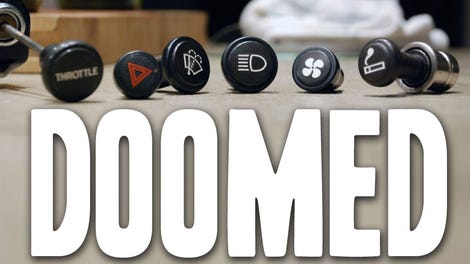by Jason Torchinsky jason@jalopnik.com @JasonTorchinsky
 |
| The Sad Death Of The Knob, Switch And Button |
Knobs are still around, albeit in reduced numbers, but it's very clear they're considered vestigial holdouts and it's just a matter of time before they're done away with completely. Looking at forward-thinking cars like the Tesla Model S demonstrates this, as its dash is basically just two big iPads, one in landscape orientation and the other in portrait.
A booth from Denso, a major supplier of auto parts and electronics, shows a prototype cockpit of the future — and it's all touch screens. Touch screens are great on our phones and tablets; so why wouldn't they be great in a car, right?
The problem has to do more with the "screen" part than the "touch" part, though both are factors. On your phone, you're looking at the screen, interacting with it very directly; the visual feedback is essential for operating the interface.
When you're driving, ideally you're looking mostly out of the big window in front of you, and you operate most of the ancillary controls with no more than a quick glance. Touch screens don't work like that; little buttons on smooth glass surfaces have to be targeted with a pair of eyes.
All you need to do to prove the point is to look up.
Have you ever peeked in the cockpit of an airplane and seen the levers in between the seats? Those levers have funny-shaped knobs: Spool-shaped, crown-shaped, star-shaped — it's the marshmallows from a Lucky Charms box. There is, of course, a great reason why they're like that: so pilots can know what lever is what just by touch.
That's exactly what is being given up when controls move to the touch screen. Tactile feedback and the ability to feel what a control is has long been part of driving.
Traditionally, we can feel and know what's a radio knob, what a climate control lever feels like, how the notches feel as we move them from one setting to another, and it's worked great. Even without any interior lights or dash lights I bet most of us could find and use the essential controls on our cars.
Touch screens are awesome for many, many things. They look great, they can show an incredible amount of information, but they should never be the only components on a dash.
Oh, but that's not the only problem. Some cars, like the Chevy Volt, the Cadillac ATS and everything from Lincoln are replacing standard buttons with sleek capacitive touch plates with big clusters of identically-shaped buttons. Capacitive technology refers to using electrodes to sense the conductive properties of objects, such as a finger. So, basically, rather than physically depressing a button you've fumbled for while your eyes remained on the road, you'll turn on and off four different things before finally looking down to find what function you want to change. Then you crash and die.
So those suck in about the same way touch screens do, and they look like they came off a VCR. So knock that off, too.
Automakers, I'm pleading with you, spare the life of just a few knobs, just some essential ones, even if they have redundant touch-screen controls. Leave me some knobs in the cars of the future. Nice, chunky, clicky knobs, and maybe a lever, switch and button or two.
I'll even let you make them look cool and LED-lit or whatever you want.
http://jalopnik.com
See also:
Any Carmaker Still Not Using A Touchscreen For Their Infotainment System Is An Id...
by Jason Torchinsky
... I like physical controls for things like, say, radio volume and tuning, too. This is not a screed against physical controls. It’s a screed against terrible physical controls used to control an on-screen interface that is clearly, obviously, much more suited to touch controls.

0 commenti :
Posta un commento